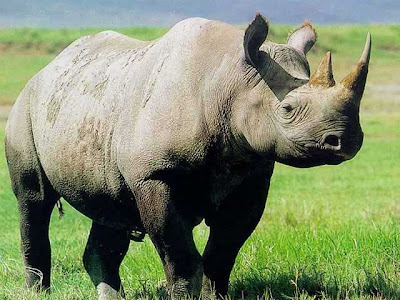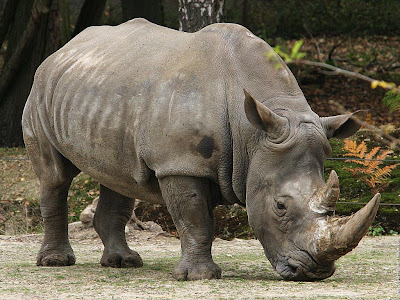Badak (Rhinocerus)
Rhinos live in home ranges that sometimes overlap with each other. Feeding grounds, water holes and wallows may be shared. The black rhino is usually solitary. The white rhino tends to be much more gregarious. Rhinos are also rather ill-tempered and have become more so in areas where they have been constantly disturbed. While their eyesight is poor, which is probably why they will sometimes charge without apparent reason, their sense of smell and hearing are very good.  They have an extended "vocabulary" of growls, grunts, squeaks, snorts and bellows. When attacking, the rhino lowers its head, snorts, breaks into a gallop reaching speeds of 30 miles an hour, and gores or strikes powerful blows with its horns. Still, for all its bulk, the rhino is very agile and can quickly turn in a small space. The rhino has a symbiotic relationship with oxpeckers, also called tick birds. In Swahili the tick bird is named "askari wa kifaru," meaning "the rhino's guard." The bird eats ticks it finds on the rhino and noisily warns of danger. Although the birds also eat blood from sores on the rhino's skin and thus obstruct healing, they are still tolerated.
They have an extended "vocabulary" of growls, grunts, squeaks, snorts and bellows. When attacking, the rhino lowers its head, snorts, breaks into a gallop reaching speeds of 30 miles an hour, and gores or strikes powerful blows with its horns. Still, for all its bulk, the rhino is very agile and can quickly turn in a small space. The rhino has a symbiotic relationship with oxpeckers, also called tick birds. In Swahili the tick bird is named "askari wa kifaru," meaning "the rhino's guard." The bird eats ticks it finds on the rhino and noisily warns of danger. Although the birds also eat blood from sores on the rhino's skin and thus obstruct healing, they are still tolerated.  There are five species of rhinos , two African and three Asian. The African species are the white and black rhinos. Both species have two horns. Asian rhinos include the Indian and the Javan, each with one horn, and the Sumatran, which has two.
There are five species of rhinos , two African and three Asian. The African species are the white and black rhinos. Both species have two horns. Asian rhinos include the Indian and the Javan, each with one horn, and the Sumatran, which has two.  The white rhino is the second largest land mammal next to the elephant. The five species range in weight from 750 pounds to 8,000 pounds and stand anywhere from four and a half to six feet tall.
The white rhino is the second largest land mammal next to the elephant. The five species range in weight from 750 pounds to 8,000 pounds and stand anywhere from four and a half to six feet tall.
 Black Rhino (Diceros bicornis): 2,400, White rhino ( Ceratotherium simum ) : 7,500, Sumatran Rhino (Dicherorrhinus sumatrensis), Javan Rhino (Rhinoceros sondaicus), Indian Rhino (Rhinoceros unicornis)
Black Rhino (Diceros bicornis): 2,400, White rhino ( Ceratotherium simum ) : 7,500, Sumatran Rhino (Dicherorrhinus sumatrensis), Javan Rhino (Rhinoceros sondaicus), Indian Rhino (Rhinoceros unicornis)


src="http://pagead2.googlesyndication.com/pagead/show_ads.js" type="text/javascript">
src="http://pagead2.googlesyndication.com/pagead/show_ads.js" type="text/javascript">
 They have an extended "vocabulary" of growls, grunts, squeaks, snorts and bellows. When attacking, the rhino lowers its head, snorts, breaks into a gallop reaching speeds of 30 miles an hour, and gores or strikes powerful blows with its horns. Still, for all its bulk, the rhino is very agile and can quickly turn in a small space. The rhino has a symbiotic relationship with oxpeckers, also called tick birds. In Swahili the tick bird is named "askari wa kifaru," meaning "the rhino's guard." The bird eats ticks it finds on the rhino and noisily warns of danger. Although the birds also eat blood from sores on the rhino's skin and thus obstruct healing, they are still tolerated.
They have an extended "vocabulary" of growls, grunts, squeaks, snorts and bellows. When attacking, the rhino lowers its head, snorts, breaks into a gallop reaching speeds of 30 miles an hour, and gores or strikes powerful blows with its horns. Still, for all its bulk, the rhino is very agile and can quickly turn in a small space. The rhino has a symbiotic relationship with oxpeckers, also called tick birds. In Swahili the tick bird is named "askari wa kifaru," meaning "the rhino's guard." The bird eats ticks it finds on the rhino and noisily warns of danger. Although the birds also eat blood from sores on the rhino's skin and thus obstruct healing, they are still tolerated. The closest rhino relationship is between a female and her calf, lasting from 2 to 4 years. As the older calves mature, they leave their mothers and may join other females and their young, where they are tolerated for some time before living completely on their own.
 There are five species of rhinos , two African and three Asian. The African species are the white and black rhinos. Both species have two horns. Asian rhinos include the Indian and the Javan, each with one horn, and the Sumatran, which has two.
There are five species of rhinos , two African and three Asian. The African species are the white and black rhinos. Both species have two horns. Asian rhinos include the Indian and the Javan, each with one horn, and the Sumatran, which has two.  The white rhino is the second largest land mammal next to the elephant. The five species range in weight from 750 pounds to 8,000 pounds and stand anywhere from four and a half to six feet tall.
The white rhino is the second largest land mammal next to the elephant. The five species range in weight from 750 pounds to 8,000 pounds and stand anywhere from four and a half to six feet tall. Black Rhino (Diceros bicornis): 2,400, White rhino ( Ceratotherium simum ) : 7,500, Sumatran Rhino (Dicherorrhinus sumatrensis), Javan Rhino (Rhinoceros sondaicus), Indian Rhino (Rhinoceros unicornis)
Black Rhino (Diceros bicornis): 2,400, White rhino ( Ceratotherium simum ) : 7,500, Sumatran Rhino (Dicherorrhinus sumatrensis), Javan Rhino (Rhinoceros sondaicus), Indian Rhino (Rhinoceros unicornis)
Convention on International Trade in Endangered Species of Wild Fauna and Flora, an international treaty with more than 144 member countries. Appendix I listed species cannot be traded commercially. Appendix II listed species can be traded commercially only if trade does not harm their survival.

src="http://pagead2.googlesyndication.com/pagead/show_ads.js" type="text/javascript">
src="http://pagead2.googlesyndication.com/pagead/show_ads.js" type="text/javascript">


Comments
Post a Comment